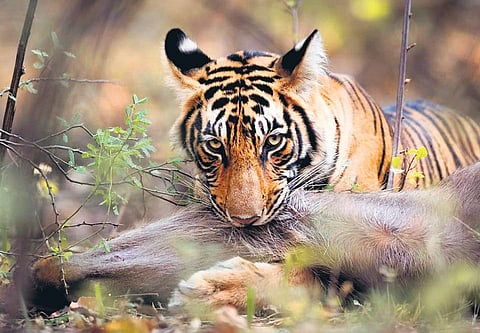

Going from spending 16 hours a day trading in stocks and shares in a presumably Boiler Room-type situation to lurking silently in the shadows for days in order to obtain just a few frames of your elusive target sounds like a long journey. But Arjun Anand has managed it in a fairly short period of time.
“It was bad,” says the 38-year-old entrepreneur (“one company did well, the other tanked”), investor (“long term ones give me plenty of free time”) and now Wildlife Photographer, referring to the heady days of stock exchanges. Anand has just come out with a coffee-table photography book, Hamir – The Fallen Prince of Ranthambhore, which recounts the story of T-104, formerly fondly known as Hamir by locals, and the surround environs of Ranthambore National Park, home to 70 of India’s nationals.
Late last year, Hamir was captured after having killed three villagers where his territory enfolds into theirs. He is now kept in an enclosure, where his fate is to be decided. “I’d thought I’d spend a decade or more with Hamir, and the book, to be published much later, would have a happy ending... But the ending is coming much sooner than expected,” rues Anand, who tracked the roughly four-year-old Hamir since the latter was six-eight months old.
Anand has been fascinated with the outdoors since the age of seven, when he was taken to his first national park. He began photographing tigers and other wild animals from the age of 15, though “I only got seriously into photography in 2015, and began doing it full time in 2017.” While tracking Hamir over three years, he spent around 200 days in the jungles. “My longest dry spell was when I didn’t see him for 13 days, but then there would be days when he would be out there in the open for hours, not doing anything,” says Anand.
However, it may not just be that. As Anand points out, the incidence of tiger-human conflicts has only risen in the last several years, and this is admittedly a bittersweet testament to the success of Project Tiger and other conservation efforts, which has seen the Indian Tiger population rebound with a roar. But, tigers require a lot of space while humans are continuing to pull down forest for economic activities.
“Everyone in the forest department and other agencies says that this is going to be the next big challenge: replenishing the forest cover and creating ‘tiger corridors’.”With everything in limbo thanks to the pandemic, including the fate of Hamir, Anand has given it till January 2021 for things to begin to get back to normal: “I’d spent years photographing tigers and wildlife just for fun, but after all the time I spent and experiences I had while tracking Hamir, I don’t think I can go back to that. So, I hope to find a new subject when I return to Ranthambore.”